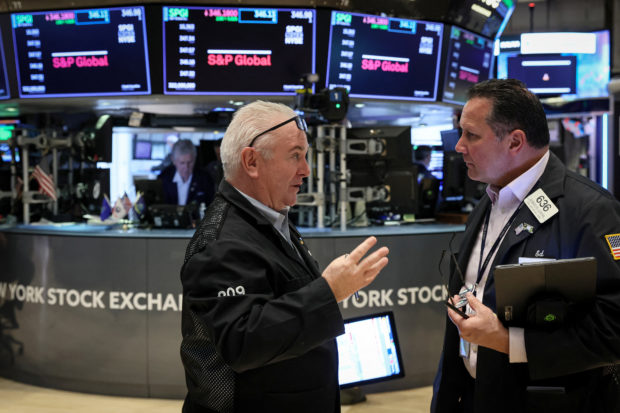
Traders work on the floor of the New York Stock Exchange (NYSE) in New York City, U.S., Feb 27, 2023. REUTERS/Brendan McDermid/File photo
NEW YORK – U.S. stocks closed out February in subdued fashion and each of the three major indexes ended with monthly declines, as investors continue to assess whether interest rates will remain high for an extended period of time.
After a strong performance in January, stocks retreated in February as economic data and comments from U.S. Federal Reserve officials prompted market participants to reconsider the odds the central bank would hike rates to a higher level than market forecasts and keep them elevated for longer than was initially expected.
“The market in many ways expected things to go south more quickly, forcing the Fed to pivot, or pause, or cut rates sooner than the Fed was saying,” said Johan Grahn, head ETF market strategist at Allianz Investment Management in Minneapolis.
“The staying power of the Fed is much more determined and steadfast than the staying power of investors so it’s back to the old mantra of do you really want to fight the Fed on this and in this case it is still a mistake to try and do that.”
The Dow Jones Industrial Average fell 232.39 points, or 0.71 percent, to 32,656.7, the S&P 500 lost 12.09 points, or 0.30 percent, to 3,970.15 and the Nasdaq Composite dropped 11.44 points, or 0.1 percent, to 11,455.54.
For the month, the S&P 500 fell 2.61 percent, the Dow slid 4.19 percent and the Nasdaq shed 1.11 percent.
Traders have started to price in the chances of a bigger 50 basis-point rate hike in March, although the odds remain low at about 23 percent, according to Fed fund futures, which suggest rates peaking at 5.4 percent by September, up from 4.57 percent now.
BofA Global Research cautioned the Fed could even hike interest rates to nearly 6 percent.
Economic data on Tuesday, however showed a reading of consumer confidence unexpectedly fell in February, while a gauge of home prices slowed further in December.
The blue-chip Dow dipped, weighed down by a 3.8- percent drop in Goldman Sachs after chief executive David Solomon said the bank was considering “strategic alternatives” for its consumer business.
The two-year U.S. Treasury yield, which typically moves in step with interest rate expectations, was up 2.3 basis points at 4.816 percent. A pullback in yields following the economic data helped boost the S&P 500 and Nasdaq, but the two indexes faded late in the session to close lower.
Volatility has been common since the Fed began its rate hiking cycle last year. The S&P 500 has seen 18 sessions with gains or losses of at least 1 percent this year, equal to the first two months of 2022, which eventually saw 122 such trading days on the year.
Chicago Fed President Austan Goolsbee said the Fed must supplement traditional government data and readings from financial markets with real-time, on-the-ground observations of economic conditions if it is to make good policy, and not rely on market reactions.
Meta Platforms rose 3.19 percent after the Facebook parent said it was creating a new top-level product group focused on generative artificial intelligence.
Target Corp gained 1.01 percent after the big-box retailer reported a surprise rise in holiday-quarter sales but cautioned on 2023 earnings due to an uncertain U.S. economy.
Norwegian Cruise Line Holdings Ltd plunged 10.18 percent after the cruise operator’s full-year profit forecast fell short of estimates. It attributes the squeeze to soaring fuel and labor costs.
Volume on U.S. exchanges was 11.63 billion shares, compared with the 11.46 billion average for the full session over the last 20 trading days.
Declining issues outnumbered advancing ones on the NYSE by a 1.13-to-1 ratio; on Nasdaq, a 1.03-to-1 ratio favored advancers.
The S&P 500 posted 9 new 52-week highs and 10 new lows; the Nasdaq Composite recorded 85 new highs and 91 new lows.
RELATED STORY:
Markets fall as Fed officials flag rates to go higher for longer